What the ... ?
I’m on the road frequently. Sometimes to visit some of you, collaborators and field research sites, and at other times to give talks here and there. I enjoy traveling, so I don’t mind it. I’ll never achieve 10-million-frequent-flyer-mile status like George Clooney’s character in the movie "Up in the Air." I travel, but I don’t travel that much; otherwise, I might come home to an empty house—no wife and no dog.
I come across interesting observations during my travels. And I come across some pest management-related issues, even on hotel premises, quite frequently.
Here's one I encountered just a few weeks ago in a hotel in North Carolina. What’s going on? This is an easy one ...
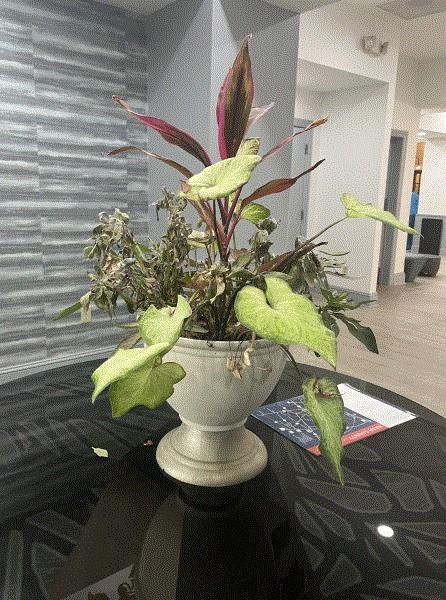
Syngenta Introduces Mainspring Xtra
Syngenta announced last week that it’s introducing Mainspring Xtra to the ornamental market. This new insecticide is currently approved in 19 states. More state registrations will be approved in the coming months.
Y’all know Mainspring GNL, right? It contains cyantraniliprole and one of my go-to for thrips, whitefly, flea beetle and caterpillar management. So where does the “Xtra” come from? That Xtra is thiamethoxam, the active ingredient of Flagship 25WG.
Both cyantraniliprole and thiamethoxam are systemic insecticides, but they have different modes of action (cyantraniliprole is a diamide, or IRAC 28, and thiamethoxam is a neonicotinoid, or IRAC 4A), and chemical and insecticidal properties. The combination is complimentary. Thiamethoxam provides fast activity and cyantraniliprole provides residual control. The addition of thiamethoxam also enhances cyantraniliprole’s activity on sucking insects, such as aphids and whiteflies.

Mainspring Xtra is registered for use on ornamental plants in commercial and residential landscapes, as well as ornamental plants, non-bearing fruit and nut trees, Christmas tree seedlings, and vegetable transplants (such as eggplant, pepper and tomato) in greenhouses, shadehouses, nurseries and interiorscapes. I guess the new uses on edible plants are also an “Xtra” to the original Mainspring GNL.
Mainspring Xtra is formulated as a water-dispersible granule (WDG or WG). It can be applied via foliar spray, media drench, cold fogging and chemigation. Application rates range from 2.5 to 10.5 oz. per 100 gal. or 5 to 10.5 oz. per acre depending on use site, application method, pest and crop.
After comparing the labels of Mainspring Xtra, Mainspring GNL and Flagship 25WG, I found that the low application rate of Mainspring Xtra (2.5 oz. per 100 gal.) delivers the same amount of thiamethoxam as the low rate of Flagship 25WG (2 oz. per 100 gal.), but slightly less cyantraniliprole than the low rate of Mainspring GNL (2 fl. oz. per 100 gal.). The maximum label rate of Mainspring Xtra (10.5 oz. per 100 gal.) also delivers the same amount of thiamethoxam as the high rate of Flagship 25WG (8.5 oz. per 100 gal.) and an amount of cyantraniliprole that’s between the high and maximum rates (8 and 16 fl. oz. per 100 gal., respectively) of Mainspring GNL.
The restricted entry interval (REI) of Mainspring Xtra is 12 hours, but is extended to 24 hours if the product is applied with cold foggers in unventilated greenhouses. Early entry is permitted after certain personal protective equipment (PPE) and ventilation requirements are met. PPE are pretty standard—coveralls, chemical resistant gloves, shoes plus socks and protective eyewear. I need to point out that Mainspring Xtra has a bee box, so y’all must follow label restrictions and instructions for pollinator protection.
Go HERE to find more information—including approved states, label and other literature—of Mainspring Xtra. You’ll find specific instructions on pollinator protection, REI and PPE on the label.

How Well Does Mainspring Xtra Work?
Having a new pre-mix that has two complementary active ingredients is nice and well, but it’s all moot if the pre-mix doesn’t add value in terms of pest spectrum, efficacy and residual longevity compared to the single product or existing competitors.
I did research with an earlier formulation of Mainspring Xtra (known as A16901B 45WG, which is a formulation with higher amounts of active ingredients), so the data from my own research doesn’t provide direct comparison between the experimental formulation and the current formulation of Mainspring Xtra. So I took a look at data provided by Syngenta to answer the question on efficacy.
Efficacy data against western flower thrips and whitefly are provided in the technical bulletin of Mainspring Xtra. I’ll discuss the data on whitefly today since some folks are currently battling whiteflies on poinsettias. In this study, Mainspring Xtra was applied as a drench and foliar spray, and was compared to Safari 20 SG and Flagship 25 WG.
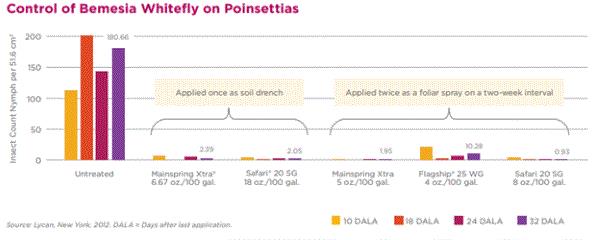
All tested products achieved excellent reduction of whitefly numbers on poinsettias compared to the untreated check. As drench treatment, Mainspring Xtra was applied once at 6.67 oz. per 100 gal. and Safari was applied once at 18 oz. per 100 gal. Mainspring Xtra achieved the same efficacy and longevity (up to at least 32 days after treatment) as Safari.
Mainspring Xtra (at 5 oz. per 100 gal.), Flagship (at 4 oz per 100 gal.) and Safari (at 8 oz. per 100 gal.) were also applied twice (at two-week intervals) as foliar sprays. Mainspring Xtra again achieved the same efficacy and longevity as Safari, but slightly better efficacy than Flagship.
In addition to the whitefly efficacy data discussed above, the Mainspring Xtra tech sheet also contains data on western flower thrips. Go HERE for the tech sheet and more trial data on fungus gnats and leafminers.
The high efficacy of Mainspring Xtra isn’t a surprise to me since it provides amounts of cyantraniliprole and thiamethoxam that are similar to the original Mainspring GNL and Flagship 25 WG. I think the true value of Mainspring Xtra lies in the ability of the two active ingredients to complement each other and expand the efficacy against a broader spectrum of insect pests. For example, cyantraniliprole makes up for the weakness of thiamethoxam against caterpillars, and thiamethoxam enhances the efficacy of cyantraniliprole against thrips and soft scales.

New Disease Diagnosis Course
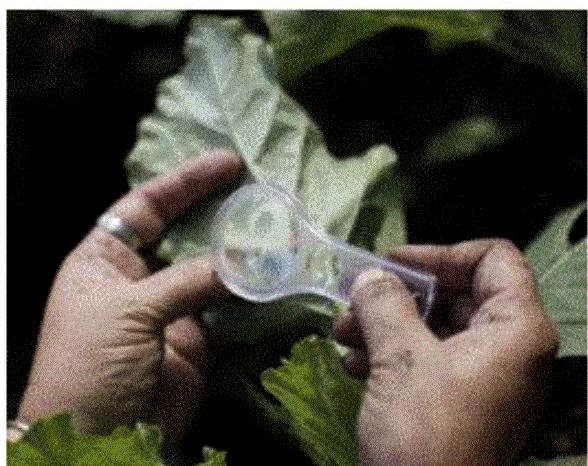
The University of Florida (UF) Greenhouse Training Online program has introduced a new course: Field Diagnosis of Plant Diseases. This course and the Nutrient Management 2 (Advanced) in the same series will start September 16. Go HERE to register for the courses.
The Field Diagnosis of Plant Diseases course will be taught by Carrie Harmon, the Director of UF/IFAS Plant Diagnostic Center. With Carrie's experience in disease diagnosis, you know you'll learn plenty of hands-on, practical methods in identifying plant diseases. This course complements the exisiting Disease Management course in the online learning and the Plant Health Professional certification program.
The Nutrient Management 2 (Advanced) course will be taught by Paul Fisher, a professor at UF and the creator of this online learning program. This is a good course to take if you want to be able to diagnosis nutritional and abiotic issues and to manage these issues.
The courses run from September 16 to October 11. The cost for each course is $275 with a discount to a group of five or more. Go HERE to register for the course.

Answer to “What the … ?”
Spider mites, my friends, holy spider mites! We’d be ashamed if we allowed such an infestation to develop in our greenhouses or nurseries, but it isn’t that uncommon in interiorscapes. I’ve come across many dripping strands of spider mites in conservatories and lobbies while sitting under a palm tree. Those dry, dusty leaves in air-conditioned interiorscapes are great for preventing diseases, but they’re also great for growing spider mites.
Unfortunately, not a whole lot can be done when it’s this bad. Discarding the plant is just about the only way to go. In this case, I found that the infested impatiens plants were stripped of all their leaves the day after I took the picture, although the stems of the impatiens, as well as the entity of the caladium and the cordyline, were still there. I wondered if the hotel manager saw me taking the photo and decided to do something about it?
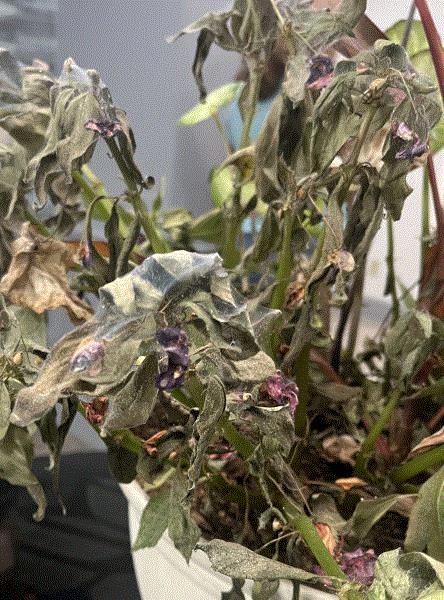
There’s not really any miticide I would use while the plants are on display. Sure, quite a few miticides are registered for use in interiorscapes, such as various azadirachtin products: Akari (fenpyroximate; IRAC 21A), Floramite (bifenazate; 20D), Hexygon (hexythiazox; 10A), Magus (fenazaquin; 21A), Shuttle (acequinocyl; 20B) Sirocco (abamectin + bifenazate; 6 + 20D), Sultan (cyflumetofen; 25), TetraSan (etoxazole; 10B); and some insecticidal soaps and horticultural oil. But I wouldn’t be spraying right there and when guests are walking around, so either do it when everyone is sleeping or (if the plants are movable) take the plants outside for spraying. Regularly misting of leaves may work; I haven’t tried it.
Go HERE and HERE for a couple of resources on managing different mite species on ornamental plants in nurseries, greenhouses, interiorscapes and landscapes.

Paul Pilon’s Mysterious Finds
If you haven’t read the last issue of Perennial Pulse, I highly recommend it because Paul has found something that I don’t see frequently in my neck of the woods. Well, first of all, I simply can’t grow echinacea even though they’re blooming beautifully in my mother-in-law’s garden. That points to the fact that I’m a lousy or careless gardener.
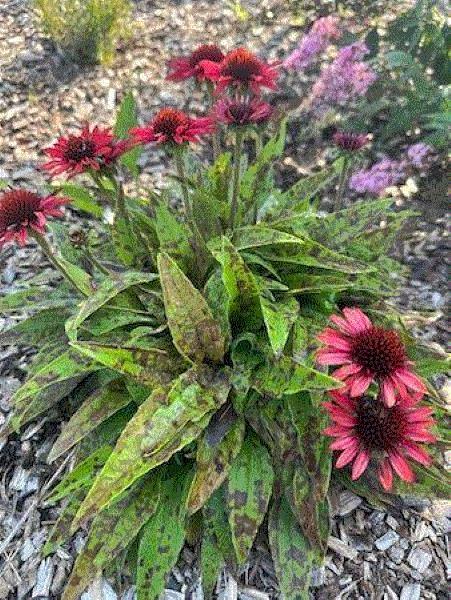
The echinacea is showing symptoms that point to lots of possibilities. Bacterial leaf spot, foliar nematodes, a nutritional issue, herbicide injury—they all came across my mind when I looked at the picture.
I’m not going to spill the beans here. Go to Paul’s Perennial Pulse HERE and check it out.
A Correction
How do I know folks are actually reading this e-newsletter? Sure, I can look at the open rate of the emails, but opening doesn’t mean reading. I open every email from the company’s mothership, but it doesn’t mean I read every line in the emails. (Shh ... don’t tell my boss.)
I know you’re reading this enewsletter when you ask me follow-up questions, share your observations or tell me I’m a fumbling fool. Last week, I talked about managing aphids on mums and mistakenly identified flupyradifurone as Aria. Well, the trade name of flupyradifurone is Altus, not Aria. (Dummy!)
The newsletter was sent out when I was doing extension agent training in Raleigh, North Carolina. Within a few minutes of delivery, I received a text from my counterpart at Envu, Janna Beckerman, telling me that I’d made a boo-boo. Now I know Janna and some of her cohorts at Envu are reading my newsletter!
Did I make a mistake in this issue or any of the previous and future issues? Tell me! If you’ve subscribed to this newsletter for years (thank you, even if you only open the emails 1% of the time), you know that I have super-thick skin. In fact, it doesn’t take knowing me for years, like Janna, to know that you can point out my mistakes.
Keep those "you-dummy" emails coming!


See y'all later!

JC Chong
Technical Development Manager at SePRO
Adjunct Professor at Clemson University
This e-mail received by 27,847 subscribers like you!
If you're interested in advertising on PestTalks contact Kim Brown ASAP!